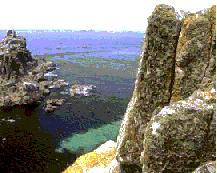Cornish language
Cornish is another good example of how a language assimilated by a greater
power can be revived and restored. About fifty years ago Cornish was considered
dead by everyone. Now, while it is still called extinct, it is no longer
dead, and language communities become more and more active in promoting
the language in books, publications, universities, on the Web.
 The
language belonged to the people who lived on the peninsula, Celtic since
they were called Britons. Cornwall was independent even in Anglo-Saxon
time, and though some migrants from the peninsula flew in Bretagne, the
population remained Celtic. In the 11th century it was conquered by Normans
and since then Cornish people slowly began to die out together with their
language which was replaced by English. Cornwall is not a community isolated
by mountains such as Scotland and Wales - soon the language stopped defending,
and in the 18th century the last speakers of Cornish disappeared, leaving
just rich literature. It dates back to the 15th century and is represented
mainly by poetry - there are a lot of verses from the 16th and 17th centuries
written in Cornish.
The
language belonged to the people who lived on the peninsula, Celtic since
they were called Britons. Cornwall was independent even in Anglo-Saxon
time, and though some migrants from the peninsula flew in Bretagne, the
population remained Celtic. In the 11th century it was conquered by Normans
and since then Cornish people slowly began to die out together with their
language which was replaced by English. Cornwall is not a community isolated
by mountains such as Scotland and Wales - soon the language stopped defending,
and in the 18th century the last speakers of Cornish disappeared, leaving
just rich literature. It dates back to the 15th century and is represented
mainly by poetry - there are a lot of verses from the 16th and 17th centuries
written in Cornish.
The language is closely related to Breton, less relative to Welsh,
Gaelic and Manx. Nowadays
linguistic societies divide the language into three main versions or dialects
called Kemmyn, Unified and Modern. Of them, Modern is based on the Middle
and Old Cornish lexics and grammar, Kemmyn and Unified are very much the
same with only difference in spelling. But the structure, the unique Celtic
morphological structure, remains the same everywhere, and Cornish also
has prepositional pronouns, initial mutations and verb-based syntax.
Cornish is certainly much more hard to study than English. But if I
were Cornish, I would study it, and I believe people in Cornwall will give
this beautiful tongue a chance for a revival.
 The
language belonged to the people who lived on the peninsula, Celtic since
they were called Britons. Cornwall was independent even in Anglo-Saxon
time, and though some migrants from the peninsula flew in Bretagne, the
population remained Celtic. In the 11th century it was conquered by Normans
and since then Cornish people slowly began to die out together with their
language which was replaced by English. Cornwall is not a community isolated
by mountains such as Scotland and Wales - soon the language stopped defending,
and in the 18th century the last speakers of Cornish disappeared, leaving
just rich literature. It dates back to the 15th century and is represented
mainly by poetry - there are a lot of verses from the 16th and 17th centuries
written in Cornish.
The
language belonged to the people who lived on the peninsula, Celtic since
they were called Britons. Cornwall was independent even in Anglo-Saxon
time, and though some migrants from the peninsula flew in Bretagne, the
population remained Celtic. In the 11th century it was conquered by Normans
and since then Cornish people slowly began to die out together with their
language which was replaced by English. Cornwall is not a community isolated
by mountains such as Scotland and Wales - soon the language stopped defending,
and in the 18th century the last speakers of Cornish disappeared, leaving
just rich literature. It dates back to the 15th century and is represented
mainly by poetry - there are a lot of verses from the 16th and 17th centuries
written in Cornish.